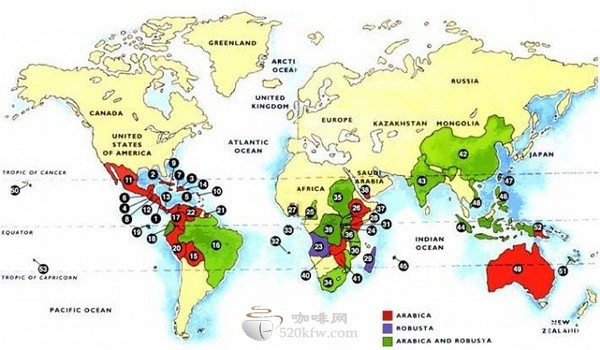53 coffee producing areas in the world

one. Costa Rican coffee
Full particles, ideal acidity, unique and strong fragrance
Tarrazu in Costa Rica is one of the major coffee producing areas in the world. The coffee produced is light and pure in flavor and pleasant in aroma. Costa Rica, with its fertile volcanic soil and good drainage, is the first country in Central America to grow coffee and bananas for commercial value. Coffee and bananas are the country's main exports. Coffee was introduced into Costa Rica from Cuba in 1729 and today its coffee industry is one of the most well-organized industries in the world with a yield of 1700 kg per hectare. Costa Rica, with a population of only 3.5 million, has 400 million coffee trees, and coffee exports account for 25 per cent of the country's total exports. Costa Rica has also benefited from the Central American Society for Agricultural Research (Turrialba) in Tarasu.
Of the Central American Agricultural Research
Institute (IAAC for short), it is an important international research center.
High-quality Costa Rican coffee is called "extra hard beans". This kind of coffee can grow above 1500 meters above sea level. Altitude has always been a problem for coffee growers. The higher the altitude, the better the coffee beans, not only because the higher altitude can increase the acidity of the coffee beans and thus increase the flavor, but also because the night temperature at the higher altitude is lower, which can make the trees grow slowly, thus making the coffee beans have a stronger flavor. In addition, due to the high altitude drop caused by sufficient rainfall, is also very beneficial to the growth of coffee trees. However, while there are many advantages to growing coffee at higher elevations, the resulting additional transport costs must be taken into account, which is likely to make coffee production unprofitable. The coffee industry in Costa Rica has adopted new technologies to increase efficiency, including the use of "electric eyes" to select beans and identify coffee beans of irregular size.
In Costa Rica, people unload coffee fruits from ox carts
Tarasu is located in the capital, San.
In the south of Jos é, it is one of the most valued coffee growers in the country. Tarasu Latin America (La Minita)
Tarrazu) coffee is a famous local product, but the production quantity is limited, about 72600 kilograms per year. It is a piece called "La".
Minita), which is owned by the last three generations of the McAlpine family in England. In fact, this land can produce more than 450 tons of coffee a year. But Tarasu Latin America coffee is grown without artificial fertilizers or insecticides, and its harvesting and selection are done by hand, in order to avoid some damage to coffee beans caused by air spray selection.
Other coffees worth mentioning are: Juan
Vinas,PR, H.Tournon, Windmill,SHB, Monte bello and Ssnta
Rosa). Fine coffee is generally grown in Geredia and the central canyon. Another striking coffee is Sarchi (one of the five towns representing Costa Rica's "Coffee Road"), which grows in the Boas volcano (Poas), 53 kilometers from San Jose
Volcano) on the hillside. Saatchi, founded in 1949, has a land area of 30770 hectares and grows sugar cane and coffee. The area is also famous for its handicrafts, attracting tourists from all over the world.
The country's coffee industry was originally owned by Costa Rica Coffee Industry Company (Instituto)
Controlled by del Caf é de Costa Rica, or ICAFE), and is now under the control of the official Coffee Committee (Oficina del)
Caf é) take over. Among the exported coffee, those products that are considered to be of substandard quality are colored with blue vegetable dyes and then transferred back to China for sale. Coffee consumed domestically (dyed blue or undyed) accounts for about 10% of total production, and local per capita coffee consumption is twice that of Italy or the United States.
two. Cuban coffee
It would be a pity if this country, which produces cigars, does not have good coffee to match it.
The best coffee in Cuba (Cuba) is Turquino or Extra.
Turquino). Tujino is a coffee grade rather than a place name, just like Blue Mountain Coffee (Blue
Mountain). This coffee has a pure flavor and moderate granules, and because it is grown at lower elevations, its acidity is lower than that of many coffees grown in Central America.
If not affected by the political climate, there is no doubt that Cuba will become an important supplier of coffee to the United States and Japan.
three. Dominica
Delicious, sweet, full-grained coffee
Republic of Dominica (Dominican
Republic) is adjacent to Haiti, both of which own the island of Hispaniola (Hispaniola). Like its neighbours, the Dominican Republic had a history of revolution and poverty, but now it has democratic elections and the country is relatively stable. Coffee was grown in the Dominican Republic in the early 18th century, and the best place to produce it was the Barahona region in the southwest, but Juncalito and Ocoa also produced a fine coffee-Santo Domingo (Santo).
Domingo) coffee is characterized by freshness and elegance, full granules, excellent acidity and pleasant aroma, so it is good value for money. Unlike coffee produced in Haiti, most of the coffee grown in the Dominican Republic has been washed, which is a symbol of high quality.
four. El Salvador
Unique, mild-tasting coffee.
El Salvador (El
Salvador) is one of the small countries in Central America with a very dense population. The flavor of its coffee is characterized by excellent balance. Today, this coffee accounts for 40% of the country's exports. 35% of the extra hard beans of the best coffee are exported to Germany from January to March.
In the early 1990s, guerrilla warfare greatly damaged the country's national economy, reducing coffee production from 3.5 million bags in the early 1970s to 2.5 million bags in 1990-1991. The eastern part of the country was most affected by guerrilla warfare, and many farmers and workers were forced to leave the manor. The shortage of funds has led to a sharp drop in coffee production, from 1200 kg per hectare in the past to less than 900kg per hectare today. In addition, the government imposed an additional 15% tariff on exported coffee in 1986, that is, an additional 15% in addition to the existing 30% tax. Taxes, together with unfavorable exchange rates, have greatly reduced the export of coffee and the quality of coffee. The government finally realized the great role of coffee in the national economy, such as solving employment, earning foreign exchange and developing agriculture, so it privatized some coffee export industries in 1990, hoping to increase the income rate of coffee in the export market. In Cuscacbapa, El Salvador, packaged coffee beans are about to be exported to El Salvador. Coffee from El Salvador is a specialty of Central America, where it is light, aromatic, pure and slightly sour. Like Guatemala and Costa Rica, coffee in El Salvador is graded according to altitude, and the higher the altitude, the better the coffee. The best brand is Pipil, which is what the Azbec-Mayan (AztecMayan) called coffee, which has obtained the American Organic Certification Society (Organic).
Certified Institute of
America). Another rare coffee is Pacamara, a hybrid of Pacas and Maragogype. The best place for this coffee is in western El Salvador, near the border with Guatemala, Santa.
Ana) adjacent. Parkmara coffee is full-grained when the aroma is not too strong.
five. Guadeloupe
Good coffee production has been affected by natural disasters this group of islands in the Caribbean used to be an important producer of coffee. In 1789, more than 1 million coffee trees on 500 hectares of land produced 4000 tons. Today, only 150 hectares of land is used to grow coffee. This decline can be attributed to the increase in sugar cane and banana production and Hurricane Hurricane in 1996.
Ines) damage to coffee trees. Political reasons include the redistribution of land from 1962 to 1965, which resulted in huge losses in coffee production. Coffee cultivation takes more man-hours and more money than bananas and sugar cane. Guadeloupe used to be the best producer of coffee, but now it is no longer exported. Bonifieur is rated as the best quality coffee in the area, a name that used to be proud of in coffee history.
six. Guatemala
The extra-hard coffee beans here are full-grained, delicious and balanced, and the pure Guatemala coffee once enjoyed a reputation as the best quality coffee in the world, but its quality also declined for a time. What is gratifying, however, is that its reputation is gradually being restored.
In 1750, Father Jesuit introduced coffee trees to Guatemala, where the coffee industry was developed by German colonization at the end of the 19th century. Today, most of the coffee industry's production takes place in the south of the country. Here it is, Sierra
Madre) the slopes of the volcano provide ideal conditions for growing high-quality coffee beans, and coffee grown at high elevations is full of vitality. Compared with other kinds of coffee, tasters prefer this mixed flavor coffee with spicy flavor. The extra-hard coffee beans here are a rare good coffee with full grains, delicious taste and balanced acidity. In addition, Guatemala has attracted a lot of attention because of its giant coffee beans. The coffee industry, which once boomed the country, still dominates the national economy. Unfortunately, the domestic political situation is not good for coffee growers. High output is usually a sign of a country's overall economic prosperity. However, coffee production in Guatemala has declined relatively, at 700kg per hectare, while that in El Salvador is 900kg per hectare and that in Costa Rica is even more astonishing, at 1700 kg per hectare. Guatemalan coffee exports are controlled by private companies, but the National Coffee Commission (Asociacion)
Nacional de
Cafe) controls other sectors of the coffee industry. At present, some of the best quality coffee from Guatemala is exported to Japan, where each cup of coffee sells for $3 to $4. Most small-scale producers are descended from the Mayans (Mayan), who like to call cups local people. Currently, they also benefit from a U.S.-funded project that locals call "The."
Project), which plans to invest US $2.5 million to encourage the opening of small, high-quality coffee plantations. The main area rich in high-quality coffee in Guatemala is Lake Lake.
Atitlan) and Huehuentenango. The purpose of the project is to help restore the vicious circle of high yield and low quality that has plagued the world coffee industry. For example, Bourbon trees grow taller and produce fewer beans than the new dwarf trees, and although they all belong to Arabica coffee varieties, bourbon trees produce better beans and are more popular with gourmets. The project also hopes to encourage local producers to process their own coffee beans, as most coffee fruits are now sold to middlemen, and if coffee processing can be done in local factories, its value and even quality may be improved.
Antigua (Antigua) is also a famous producer of coffee. Antigua coffee comes from Camana Manor (Hacienda
Carmona), the best quality coffee there is EL
Pulcal) it is not only of good quality, but also has a stronger flavor, richer taste and stronger tobacco flavor than other Guatemalan coffee. Every 30 years or so, the area near Antigua is hit by a volcanic eruption, which provides more nitrogen to the already fertile land, and plenty of rainfall and sunlight make the place more suitable for growing coffee. Other coffee producers include: San
Marco), Oriente &
Coban, Palcya, Mataquescuintia and La in Zacapa
Uman), etc. The establishment of the Special Coffee Association means that the Government of Guatemala has begun to pay attention to high-quality coffee, and the efforts made for it will soon bear fruit.
Important Notice :
前街咖啡 FrontStreet Coffee has moved to new addredd:
FrontStreet Coffee Address: 315,Donghua East Road,GuangZhou
Tel:020 38364473
- Prev

Common sense of Coffee beans about the Preservation of Coffee beans
After the coffee beans are roasted, the oxidation and aroma volatilization are irreversible. So coffee lovers have always been meticulous about the preservation of beans. This article mainly analyzes the preservation of cooked beans. I hope it will be helpful to you. one。 What is raised beans (single product) freshly roasted coffee beans can not be fully released because of too much carbon dioxide, so they are tasteless. So Dou Bing
- Next

53 coffee producing areas in the world
Seven. Haiti's Good Coffee from Politically Troubled Land Despite its well-known problems and fluctuating coffee quality, Haiti is still trying to produce some quality coffee. Most of the coffee produced in Haiti is grown in a purely natural state, not intentionally but as a result of material shortages, because farmers are too poor to buy
Related
- Beginners will see the "Coffee pull flower" guide!
- What is the difference between ice blog purified milk and ordinary milk coffee?
- Why is the Philippines the largest producer of crops in Liberia?
- For coffee extraction, should the fine powder be retained?
- How does extracted espresso fill pressed powder? How much strength does it take to press the powder?
- How to make jasmine cold extract coffee? Is the jasmine + latte good?
- Will this little toy really make the coffee taste better? How does Lily Drip affect coffee extraction?
- Will the action of slapping the filter cup also affect coffee extraction?
- What's the difference between powder-to-water ratio and powder-to-liquid ratio?
- What is the Ethiopian local species? What does it have to do with Heirloom native species?

